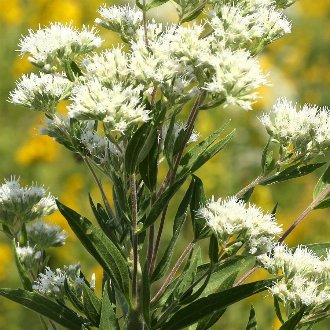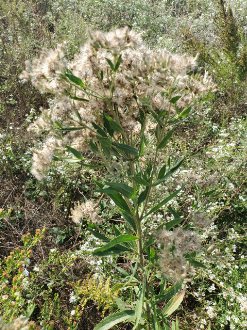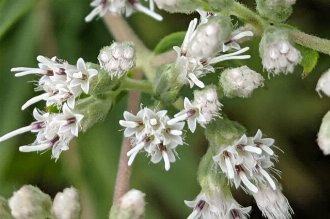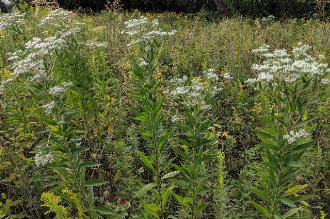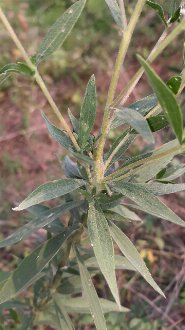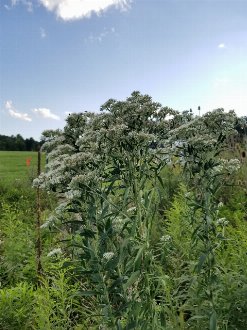Tall Thoroughwort (Eupatorium altissimum L.)
Also known as tall boneset.
↑Summary
An upright perennial of dry, sunny, disturbed habitats, often on high-pH soils, native to the eastern to central US and expanding into the northeast.
↑Range - Expand
| Legend | Color |
| Native | |
| Native or Expanded | |
| Expanded or Not Present | |
| Native or Not Present | |
| Expanded | |
| Native or Expanded or Not Present |
This map is based on our research. We have checked its accuracy to Level 3 ecoregions. Although this plant occurs somewhere in each of these regions, it may only occur in a small part of some or all of them.
We mark all new populations north of PA and NJ as expanded. This species is only occasionally planted in landscaping; although escapes can originate from garden plants, it is a weedy species with wind-dispersed seeds, readily colonizing disturbed sites along roads, railroads, and industrial areas. Furthermore, its range expansion mirrors that of Eupatorium serotinum, which is even less-frequently planted.
↑Similar Plants
↑Habitat
Tall thoroughwort is found in sunny, disturbed habitats, in mesic to dry conditions, usually in neutral-tohigh pH soil. Natural habitats include dry prairies, savannas, openings in upland woodlands, dry portions of lake banks, and limestone barrens. It is also found in numerous anthropogenic habitats, including pastures, abandoned agricultural land, fence rows, vacant lots, railroads, power line right-of-ways, and urban and industrial areas.
It needs considerable direct sun, but able to compete favorably with ground-level vegetation due to its height. In the north of its range it is usually limited to near-full-sun exposures, whereas in the south of its range it is more likely on sites shaded from afternoon sun.
It occurs in a range of soil conditions, including mollisols (black soils that often form under prairies), soils with a high clay and gravel content, compacted soils, and thin soils over bedrock, but it is usually absent from sandy soils. It is most abundant on calcareous and/or mafic soils, and tolerates high soil pH, and becomes uncommon to rare on acidic soils. In urban and industrial areas it benefits from the presence of cement and gravel which creates the dry, high-pH conditions it prefers.
We could not find information on this species' fire tolerance, but it occurs both in habitats that burn regularly and those that do not. It probably benefits from the removal of competing vegetation brought by fire, whereas in habitats that do not burn regularly, it relies on other forms of disturbance to establish.
↑Life Cycle
This species is a clumping, short-rhizomatous perennial.
Due to its preference for habitats that are drier and often lower in organic nutrients, it is slightly slower to establish than other closely-related plants. Plants may take a few years to reach their full height; established plants form clumps with multiple stems, spreading by short rhizomes, usually at most a few inches per year.
In periods of drought, leaves will dry up, but plants may still flower, and are usually unaffected in the long-run, sometimes surviving the drought better than competing vegetation.
Plants flower in late summer to early fall. There are two separate populations of this species; one, found mostly in the Ozarks in Missouri and Arkansas, reproduces sexually and must be cross-pollinated. However, the majority of populations of this plant reproduce asexually, producing seeds through agamospermy. This adaptation has likely helped this species to colonize new areas starting with an isolated individual, and also aids its reproduction on harsh sites where it cannot easily attract pollinators.
Seed matures in fall, and is wind-distributed. Seeds exhibit cold dormancy, germinating in the following growing season. Seeds usually mature gradually, over a period of several weeks, with some seed beginning to be distributed while the plant is still in bloom.
We could not find material establishing the seed banking behavior of this species with much confidence. Although many species in this genus form a long-term seed bank, we could not find verification that this species does. It has been found in the seed bank of prairies, but only in small numbers which suggests that, in these habitats, establishment may be more likely from freshly-distributed seed.
We also could not find material on this species' lifespan beyond the fact that it is a perennial able to survive several years.
↑Faunal Associations
In spite of the asexual reproduction of most populations of this plant, it still provides nectar, and attracts a wide range of pollinators, even to plants that do not produce any pollen. The flower tubes are easily accessible, and visited by long-tongued and short-tongued bees, wasps, flies, butterflies, skippers, beetles, and bugs.
Mammals, both wild herbivores and livestock, usually avoid browsing this plant due to its bitter, toxic foliage.
Larvae of several lepidoptera species eat this plant, including the clymene moth (Haploa clymene), lined ruby tiger moth (Phragmatobia lineata), the Eupatorium borer moth (Carmenta bassiformis) which bores into its roots, and the three-linend flower moth (Schinia trifascia) which eats flowers & seed capsules.
↑Uses
This plant is occasionally used as a landscaping plant, and is probably under-utilized as such. It is valued for its drought tolerance, resistance to deer browsing, and the fact that it usually grows upright and supports its weight even without any supporting vegetation.
This plant can be used in ecological restoration projects, including reclamation of abandoned industrial sites or building foundations where there is thin soil over concrete or stone, or extensive gravel or old cement mixed in with the soil. It can also be used in roadside plantings, where it has the benefit of not flopping into the road or a strip of mowed grass as much as other vegetation does. It is relatively easy to seed into an area, but it can also be transplanted in for smaller projects.
↑Related Plants
Numerous other Eupatorium species co-occur with this one in its range; all but one are native. The broader Eupatoriae tribe contains even more species, also mostly native.
↑Links & External Resources
• Eupatorium altissimum (Tall Boneset) | Illinois Wildflowers (About This Site)
• Eupatorium altissimum (tall thoroughwort) | USDA PLANTS Database (About This Site)
• Eupatorium altissimum | Go Botany (About This Site)
• Eupatorium altissimum (Tall Thoroughwort) | Missouri Botanical Garden Plant Finder (About This Site)
• Eupatorium altissimum | Biota of North America Project (BONAP) (About This Site)
• Eupatorium altissimum | NatureServe Explorer (About This Site)
• Eupatorium altissimum | Flora of North America (About This Site)
• Eupatorium altissimum | Missouri Plants (About This Site)
• Tall Thoroughwort | Maryland Biodiversity Project (About This Site)
• Eupatorium altissimum (Tall Boneset) | Minnesota Wildflowers (About This Site)
• Eupatorium altissimum L. (Tall Thoroughwort) | Digital Atlas of the Virginia Flora (About This Site)



